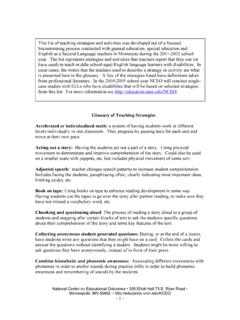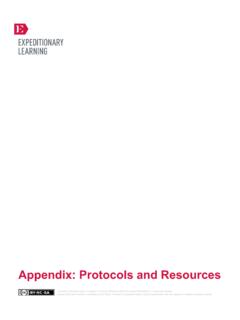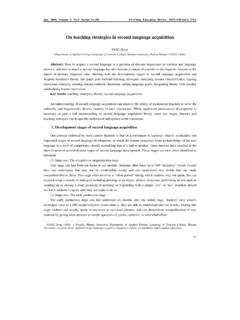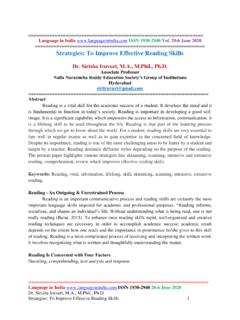Transcription of Concepts for Teaching Speaking in the English Language ...
1 LEARN Journal: Language Education and Acquisition Research Network Journal, Volume 12, Issue 1, January 2019 1 Concepts for Teaching Speaking in the English Language Classroom1 Anne Burns University of New South Wales, Australia Abstract Systematically and explicitly addressing the Teaching of Speaking is an aspect of English Language Teaching that is often underestimated. While teachers may be presenting various Speaking activities in the classroom, such activities may amount to doing Speaking rather than Teaching Speaking . In this article, I argue that being a competent teacher of Speaking involves understanding the combinatorial nature of Speaking , which includes the linguistic and discoursal features of speech, the core Speaking skills that enable speakers to process and produce speech, and the communication strategies for managing and maintaining spoken interactions.
2 The article concludes by presenting a Teaching - Speaking cycle (Goh and Burns, 2012) that teachers can use to plan tasks and activities that explicitly address these aspects of Speaking and that scaffold student learning. Keywords: Teaching Speaking , Second Language Speaking Competence, English Language Classroom Introduction The Teaching and learning of Speaking are a vital part of any Language education classroom; not only does the spoken Language offer affordances for learning as the main communicative medium of the classroom, but it is also an important component of syllabus content and learning outcomes. However, Teaching Speaking remains challenging for many English teachers. A key issue here is whether what happens in a Speaking classroom is concerned with doing Teaching or Teaching Speaking .
3 In this paper, I consider some of the essential elements that comprise Speaking competence and present a Teaching - Speaking cycle designed to address the Teaching of Speaking systematically. The paper finishes with a brief analysis of the key aspects of the Teaching - Speaking cycle identifying how it covers areas that are central to planning a holistic and sequenced approach to the Teaching of Speaking . Doing Teaching or Teaching Speaking ? Comments such as the following are familiar to many teachers working in classrooms which aim to develop Speaking skills: All my students can read and write well, but they are poor at Speaking and listening. Many of my students are too afraid to talk in class. They are shy and lack confidence. Some of my students sound very bookish when they speak it s as if they are reading from a book!
4 My students love to speak, but they make a lot of grammatical mistakes. 1 Much of the material in this paper is drawn from a recent publication, Goh, & Burns, A. (2012). Teaching Speaking : A holistic approach. New York: Cambridge University Press. I gratefully acknowledge my co-author Christine Goh for the formulation of many of the ideas presented. LEARN Journal: Language Education and Acquisition Research Network Journal, Volume 12, Issue 1, January 2019 2 These kinds of observations are not uncommon, as learning to speak in another Language is a challenging undertaking. Speaking is a highly complex and dynamic skill that involves the use of several simultaneous processes - cognitive, physical and socio-cultural - and a speaker s knowledge and skills have to be activated rapidly in real-time.
5 It is important, therefore, that Speaking should be taught explicitly in Language classrooms simply doing Speaking through a series of activities is not the same as learning the knowledge, skills and strategies of Speaking . By way of illustration, we will consider the following classroom situation: Teacher M realised from early in her career that it was important to develop her students Speaking abilities. She wanted to make sure that her students had plenty of opportunities to communicate with one another in English , so she set aside two lessons a week for Speaking practice. She planned many interesting activities for her students. Her lessons were carefully guided by instructional objectives. These objectives were in the form of either what the students should produce ( presentations, debates, descriptions) or what they had to do ( discuss, narrate, role play).
6 Sometimes when they had finished the activities, Teacher M would ask them to present the outcomes to the rest of the class. At other times she would simply move on to another activity, such as reading or writing. In several ways, Teacher M was successful in constructing her Speaking lessons. However, there were also limitations regarding how directly she was addressing the students needs to improve their Speaking . On the positive side, she presented a variety of activities, which could appeal to her students different learning styles. Clearly, her students enjoyed interacting during the lesson and the activities gave them opportunities to practise Speaking . They also had some opportunities to present the outcomes of the activities. Less positively, however, the lessons provided little preparation for practising specific Speaking skills, and they lacked any explicit Teaching of key features of Speaking .
7 The students were not encouraged to give attention to knowledge, skills, or strategy development. Also, there was little feedback on their performance, and minimal or no follow-up to the activities. What Must a Competent Speaker Be Able to Do? To teach Speaking holistically and comprehensively, it is valuable for teachers to be knowledgeable about what Speaking competence involves and how different aspects of Speaking competence relate to each other. Johnson (1996, p. 155) describes Speaking as a combinatorial skill that involves doing various things at the same time . Figure 1 below presents a model of second Language Speaking competence that comprises knowledge of Language and discourse, core Speaking skills, and communication and discourse strategies. Learning to speak in a second Language involves increasing the ability to use these components in order to produce spoken Language in a fluent, accurate and socially appropriate way, within the constraints of a speaker s cognitive processing.
8 LEARN Journal: Language Education and Acquisition Research Network Journal, Volume 12, Issue 1, January 2019 3 Figure 1: Components of second Language Speaking competence (Goh and Burns, 2012, p. 53) The first component, Knowledge of Language and Discourse, requires mastering the sound patterns of the Language (in English , this means being able to pronounce the Language intelligibly at segmental and suprasegmental levels), knowing the grammar and vocabulary of the Language (spoken structures, grammatical features, lexis) and understanding how stretches of connected speech (discourse, genre) are organised, so that they are socially and pragmatically appropriate (register). Core Speaking Skills refers to developing the ability to process speech quickly to increase fluency ( speech rate, chunking, pausing, formulaic Language , discourse markers).
9 It also involves being able to negotiate speech ( building on previous utterances, monitoring understanding, repairing communication breakdown, giving feedback), as well as managing the flow of speech as it unfolds ( , initiating topics, turn-taking, signalling intentions, opening/closing conversations). The third component, Communication Strategies, involves developing cognitive strategies to compensate for limitations in Language knowledge ( circumlocution, paraphrasing, gestures, word coinage, approximation, avoidance), metacognitve strategies ( planning in advance what to say, thinking consciously about how you say something), and interaction strategies ( asking for clarification/repetition, reformulating, rephrasing, and checking comprehension). What this model implies is that Speaking lessons are not just occasions for simply practising or doing Speaking .
10 They need to be conceptualised as structured and supported learning opportunities that develop these various components of Speaking competence. It is important that teachers guide learners systematically, introducing activities that are integrated and sequenced and that allow them to raise their awareness of the knowledge, skills and strategies needed for different types of interaction and discourse. Students may need guidance on specific aspects of the Language , such as pronunciation features, either at segmental or Second Language Speaking CompetenceKnowledge of Language and DiscourseCommunication Strategies Core Speaking Skills LEARN Journal: Language Education and Acquisition Research Network Journal, Volume 12, Issue 1, January 2019 4 suprasegmental level, or they may need support in relation to affective factors, such as anxiety, nervousness or embarrassment about Speaking in another Language .















